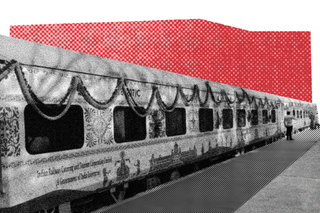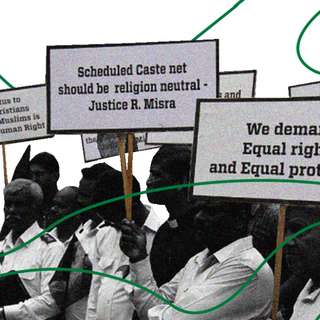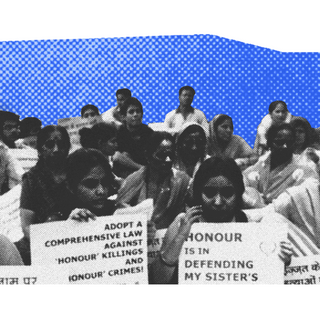
Union Tourism Ministry Announces an ‘Ambedkar Circuit Train’
By co-opting and deifying a revolutionary figure, the state takes away from Dr. Ambedkar’s radical politics.

The Union Tourism and Culture Minister on Sunday announced plans for a special “Ambedkar Circuit” Tourist Train, The Indian Express reported. In June this year, the Indian Railways unveiled a similar Tourist Train that covered the “Ramayana Circuit”, running from Ayodhya in Uttar Pradesh to the town of Janakpur in Nepal, while covering other locations thought to be significant in the mythological tale of the Hindu deity Rama. A train along similar lines covering Dr. Bhimrao Ramji Ambedkar’s life is an example of how the state uses deification as a tool to co-opt revolutionary figures, in the process deradicalizing their politics.
In the last few years, governments, political parties, and idealogues — especially those from the Hindu right — have tried to claim Dr. Ambedkar as one of their own. In books, speeches, and public appearances, right-wing ideologues have tried to find commonalities between Dr. Ambedkar and the present leadership. They take his comments on Muslims and Islam out of context to justify their own Islamophobia. They also claim that his decision to convert to Buddhism as opposed to Christianity or Islam represents his admiration for the greater “Sanatan fold” and for his motherland — as Buddhism originated in India, and Hindus believe the Buddha to be an incarnation of the Hindu God Vishnu — just like Rama.
But a closer look at the facts debunks many of these claims. Throughout his life, Dr. Ambedkar remained a staunch critic of the Brahminical practices that define Hinduism. Hindutva ideologues today claim that the birth-based caste system is not intrinsic to the Hindu religion, arguing that originally, the caste system was just a marker — and not a decider — of a person’s profession. However, Dr. Ambedkar himself never saw the caste system as separable from Hinduism, and in fact argued that caste was the foundation on which Hinduism built itself. Further, his decision to convert to Buddhism was not dictated by his perceived love of the “Sanatan fold” or the motherland but because of his interpretation of Buddhism as a religion that was equal and markedly different from the divisive Brahminism.
Related on The Swaddle:
Why Representation in Politics May Not Address Systemic Oppression
Deifying Dr. Ambedkar as analogous to the Hindu god Rama then undermines his politics — and it also gives leaders an opportunity to claim his image without implementing his ideas. For instance, Dr. Ambedkar was a staunch proponent of education as a means of eradicating the caste system. Once, while writing to an aide on ending a temple-entry Satyagraha, he mentioned, “I want the Depressed Classes to concentrate their energy and resource on politics and education and I hope that they will realize the importance of both”. Further, in a debate in the Bombay Legislative Council on the presence of members of marginalized castes in the Senate of the University, he commented, “One of the fundamental functions of the University as I understand it, is to provide facilities for bringing the highest education to the doors of the needy and the poor.”
In February this year, however, the government announced changes to the National Overseas Scholarship Scheme — an existing scheme that provided scholarships to low-income students belonging to Scheduled Castes, Scheduled Tribes, and landless agricultural laborer families to pursue post-graduate and doctoral courses overseas — withdrawing funding for “[t]opics/courses concerning Indian [c]ulture/heritage/[h]istory/[s]ocial studies on India.” Dalit scholars and politicians claim that this shows the government’s fear of a growing Dalit and Adivasi consciousness. “The history of modern India was altered because the Baroda State funded Ambedkar’s studies at Columbia University. Our rulers cannot and will not risk another Ambedkar rising,” wrote researchers Siddharth Joshi and Deepak Malghan, reacting to the government’s move.
At the same time, hate crimes against Dalits have increased steadily in the last few years, reflecting the state’s lax attitude towards caste-based atrocities. The National Crime Records Bureau Data of 2021 reveals that close to 60,000 cases of atrocities against Dalits were registered in the country in the previous year. Many other such cases go unreported and unregistered. The state however has displayed little attention or concern against rising atrocities.
Arguably, long periods of intellectual neglect and sidelining of Ambedkarite thought led an environment where co-opt Dr. Ambedkar is now possible — and even benefits those who represent everything he stood against. Many have noted how the progressive intelligentsia ignored the role of caste in shaping Indian society entirely. Mainstream education, moreover, recognizes Dr. Ambedkar solely as the architect of the Indian Constitution, while excluding his much more prolific writing on caste, South Asian society, and economics.
Statues of Dr. Amebdkar in public spaces, universities and roads named after him, when backed with ideological honesty to his views and politics, serve an important purpose in making his ideas visible and accessible to the general public. But the latter is key — sans an honest effort to implement his vision for society, anti-caste discourse only stands to be erased and worse, deradicalized.
Amlan Sarkar is a staff writer at TheSwaddle. He writes about the intersection between pop culture and politics. You can reach him on Instagram @amlansarkr.
Related


Govt Panel to Look Into Socio‑Economic Conditions of Dalit Muslims, Christians
